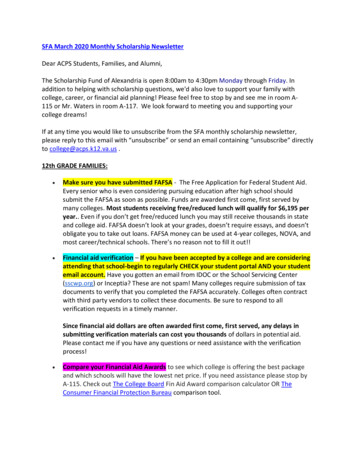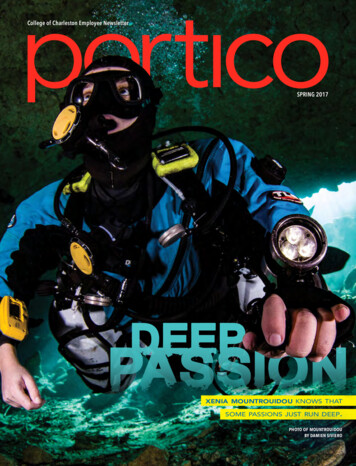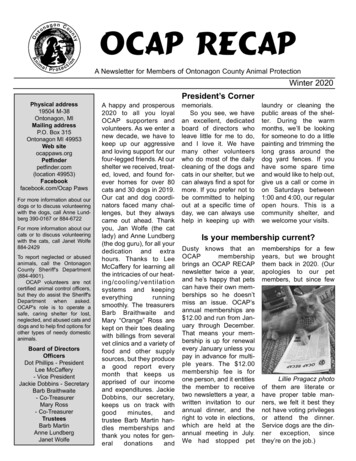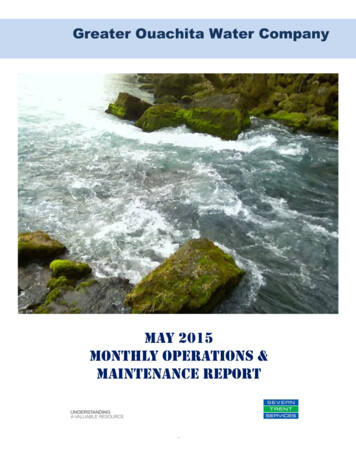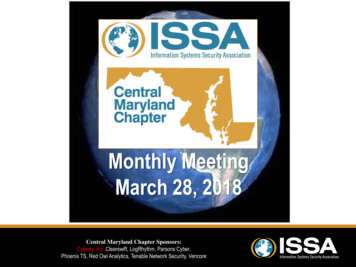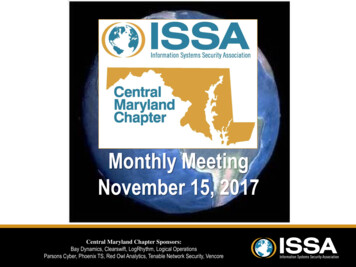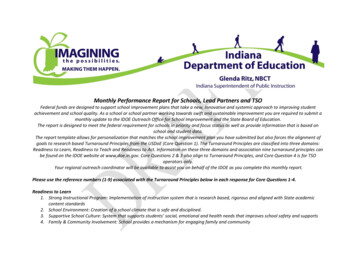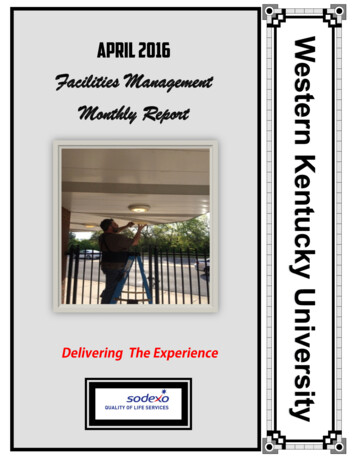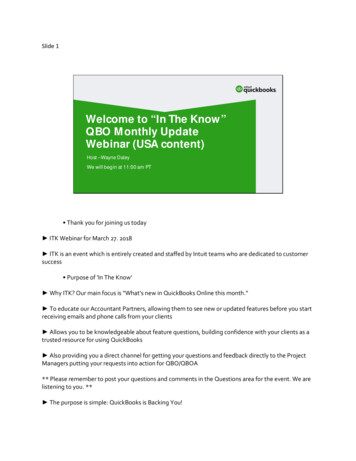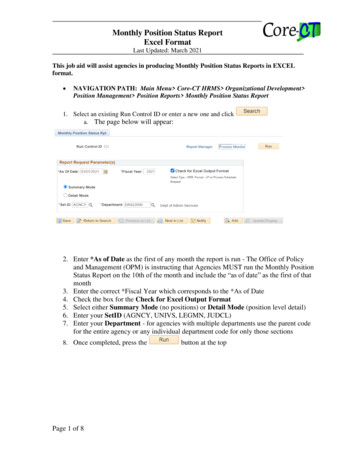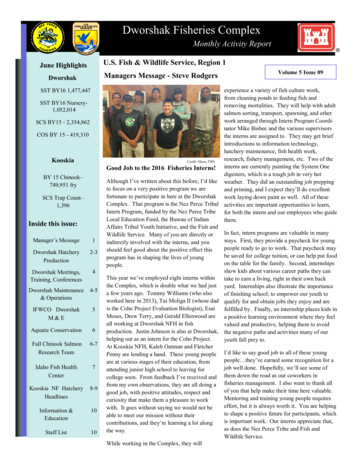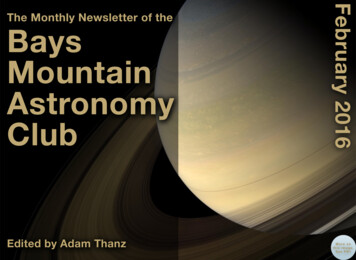
Transcription
BaysMountainAstronomyClubEdited by Adam ThanzFebruary 2016The Monthly Newsletter of theMore onthis image.See FN1
Chapter 1Looking UpBrandon Stroupe - BMAC ChairMore onthis image.See FN2
Brandon StroupeLooking UpHello BMACers,It is now February and the year is already moving right along. Weare in full swing of winter now. The weather is finally starting toseem like winter. I for one, am a person who enjoys cold weatherand snow in the winter time. It just makes no since to me to call itwinter when it is 80 degrees outside. We also seem to havebetter seeing and clearer skies this time of year for observing andMore onthis image.See FN3galaxies, forming new stars at a faster rate. Dr. Smith et al. haveused multi-wavelength (infrared, optical, ultraviolet, and X-ray)images to study this process in interacting galaxies, andcompared them with normal galaxies. Dr. Smith will be our firstspeaker to kick off the 3-part series on “Women in Astronomy.” Ihope everyone will be able to attend for I believe will be a veryinteresting presentation and series.imaging if you can bear the cold at night. Those of you “Die-For January, we didn’t have a meeting because of the annualhard” amateur astronomers know what I am talking about. Idinner. As I am writing this, we still have yet to have the dinner. Aremember many nights with layer after layer of clothes on to tryreport on the dinner will be in the next issue. We will, though,to keep myself warm while looking through the eyepiece or at mydiscuss the upcoming Astronomy Day and begin to plan what werecently captured image on the computer screen. Regardless,will offer this year to intrigue the public. We’ll also inform the clubbring on the cold weather.about the 3-part “Women in Astronomy” series that will kick off inOur meeting this month will feature Dr. Beverly Smith from ETSU.February. I foresee that the dinner will be a great time.She is a professor at their Physics and Astronomy department.Our constellation for the month of February is Gemini. Most of usHer presentation is, “Star Formation in Interacting Galaxies.”refer to it as Gemini, the Twins. The two brightest stars, CastorWhen galaxies pass near each other in space or collide,and Pollux, represent the heads of the twins of Gemini. Theyinterstellar clouds in the galaxies can be perturbed in their orbitswere known as heroes in Greek mythology because of their roleand may collide more frequently. This causes the clouds toas the protectors of sailors. When Castor died, because he wasgravitationally collapse at higher rates than in more isolatedmortal, Pollux begged his father Zeus to give his brotherBays Mountain Astronomy Club Newsletter February 20163
Gemini the Twinsimage from Stellariumlayout by Adam Thanz4Bays Mountain Astronomy Club Newsletter February 2016
immortality, and he did by uniting them together in the heavens.Other than the bright 1.6 and 1.2 magnitude Castor and Polluxstars, there are a few other notable objects in this constellation.M35 is a 5th magnitude open cluster in Gemini that lies about2,800 light-years from Earth. NGC 2158 is another open cluster inGemini that is about 12,000 light-years away. There are twoplanetary nebulae in Gemini. They are the Eskimo and Medusanebulae. Both are pretty faint nebulae and would require atelescope to see them. Another thing that the constellation isknown for is the famous Geminids meteor shower. This meteorshower produces bright, prominent meteors at the rate of about100 per hour. This shower peaked in the middle of Decemberwhen the constellation was still low on the horizon. It is defiantlyworth laying out in a lawn chair with a sleeping bag and hotcocoa or coffee. So when you are out this month, take a look upat Gemini and appreciate its beauty.That will be it for this month. As I said previously in the article, the“Women in Astronomy” series will begin this month. It will be a 3part series and it will focus on how women have and are stillmaking a significant contribution to the world of astronomy. Moreand more women are getting involved, working, and conductingresearch in this wonderful field. I believe that women are notrecognized enough for their hard work and passion for astronomy.I hope everyone will enjoy the series and let me know anythingelse you would like to see in upcoming meetings. Until nextmonth Clear Skies.5Bays Mountain Astronomy Club Newsletter February 2016
Chapter 2BMACNotesMore onthis image.See FN4
Section 1BMAC NewsBMAC Youtube!The BMAC has a YouTube channel. Click here to see what's tDQe4AaAWQ)The presentation by Steve Conard, who spoke about thetelescope instrument on the New Horizons spacecraft, is nowonline. More to edulingNote, due to scheduling needs, the June 2016 meeting will beheld on the c Mercury Transit Viewing May 9, 2016BMAC will co-host a free, public viewing of the Mercury transitMore onthis image.See ry/?GTTabs 2If you are able to spend the day, please come help. Bring ascope with a proper solar filter or use one of the Park’s scopes ifone is available.Remember, it will be outside in the sun most of the day(hopefully). Bring plenty of water, a hat, a chair, and lunch.----------------------------------------BMAC Member Eric DeBlackmere SeeksGoFundMe Support to be a PHEnOMProject’s Citizen Scientist-AstronautEric would like you to support: Help A Father Achieve Orbit!by making a donation and helping spread the word.with the ETSU Physics Dept. at ETSU on either the CPA Front orHello! My name is Eric DeBlackmere. I am a single father of twoSide Yard. The viewing is 10 a.m. to 3 p.m. BMACers wanting toboys, ages 14 and 12. I have been granted a phenomenalhelp man a scope will need to arrive by 9 a.m. If the weather isopportunity to fulfill a life-long dream by being selected as apoor, the event is cancelled. Please see the website for details.member of the SeaSpace Research Foundation'sBays Mountain Astronomy Club Newsletter February 20167
BMACer Eric DeBlackmere8Bays Mountain Astronomy Club Newsletter February 2016
PHEnOM Project:CITIZEN SCIENTIST-ASTRONAUTstudy, and “ground school” (in-person, hands-on instruction). Thetraining flow is designed to provide Candidates with anopportunity to apply their didactic knowledge to hands-onThe PHEnOM Project’s Citizen Scientist-Astronaut (CSA) corps ispractical application in multiple areas of operational relevance,comprised of talented individuals from across the world workingand is delivered over a period of 24 months. Didactic coursestogether to create and lead an unparalleled commercial humanrange in length from 9 to 16 weeks, and are equivalent to 2 – 5spaceflight research program. Our corps of Citizen Scientist-hours of semester credit. The course curriculum has beenAstronauts participate in a very comprehensive training programsubmitted to the American Council on Education for initialthat combines didactic course work with mission- andassessment. If approved, Candidates will have the opportunity tospaceflight-specific skills training. The PHEnOM Project’s CSAearn college-level credits from multiple institutions of higherprogram is delivered over a period of two years using a blendedlearning. Upon successful completion of all CSA Program traininginstructional format that combines online/web-based didacticrequirements, Candidates are eligible for suborbital spaceflightcourse work with six location-based trainings (3 each year). Duemission assignment.to the rigorous and comprehensive nature of our Citizen ScientistAstronaut training program, we request that only those who arewilling to make such a commitment apply for this program. As aleader within the PHEnOM Project, the CSA corps will be involvedin every facet of our research programs, from grant sourcing andproposal writing to data collection and final manuscript writingand publication. While much of the research conducted will beground-based (laboratory) or utilizing a spaceflight analogenvironment (parabolic flight), members of the CSA corps will alsobe assigned to commercial suborbital spaceflight missions.The PHEnOM Project’s Citizen Scientist-Astronaut (CSA) ProgramI have received confirmation today of my selection as a CSAcandidate, which is why I am here today with this request. Anintensive, two-year training program begins in February and Ineed to secure funding for my training classes. 25% ( 3125) isrequired before February to secure my position. Theremainder can be paid over the next 22 months. There is no waythat I, a single father of two, can possibly hope to raise thisamount of money on my own in so short a time. The traditionallending sources can not help me. Therefore I am turning to you,the people at large, in the hopes that someone, somewhere mightbe in a better position to help.is very similar to a hybrid academic degree program, combiningmultiple methods of instructional delivery, including online, home9Bays Mountain Astronomy Club Newsletter February 2016
I grew up in Florida during the Apollo era. It was always my 9Nfrom an early age to be an astronaut and that has fueled my life-QUlOX2tpbmdzcG9ydHRuLmdvdjs%3Dlong passion for space and space travel. I have gone back toschool to work on my graduate degrees in astrophysics. I thoughtWhat is GoFundMe?that the opportunity to fulfill my original dream had vanished untilGoFundMe is a personal fundraising website that has helpedthis opportunity arrived. I am hoping beyond hope that someonethousands of people raise millions of dollars for the things thatcan help me achieve my greatest dream and, at the same time,matter to them most.hopefully help me to create a better world for my children.This message was sent through GoFundMe's Headquarters:I thank each and everyone of you who has read this introduction. Iwould also like to thank you in advance for any help you canP.O. Box 717798 San Diego, CA 92171provide. Mere words seem so inadequate but please know thatmy gratitude would be boundless.To View the Campaign: - http://link.email.dynect.net/link.php?H gbB%2F%2BPZp%2BmAv0zkhU%2BM3my7g%3D%3D&G 21&R tm source%3Dinternal%26utm medium%3Demail%26utm content%3Dcta button%26utm campaign%3Dupd n%26pc%3Dcontact exp%26rcid%3D27c3e5a49de84de1a3e05e13dde3b82d&I om&X MHw3NzY2NjI6VEVNUElEXzEwMjE7MXw3N10Bays Mountain Astronomy Club Newsletter February 2016
Chapter 3Star StuffTe r r y A l f o r dMore onthis image.See FN5
Terry AlfordStar StuffMore onthis image.See FN3Ed.: Terry was not able to write this month’s column, so I’m goingto fill in.Da “big” news is being able to see all five naked-eye planets inthe morning sky at one time. “Sky & Telescope” has a good writeup on this with very practical information. Essentially, this isvisible from Jan. 20, 2016 to Feb. 20, 2016. BUT, “Sky & Tel”suggests to regard the altitude of Mercury. So, Jan. 22, 2016 toFeb. 10, 2016 are your best bets. I’ve added some images fromStellarium focused on the morning of Feb. 6 to include the thincrescent Moon. Get out that super-wide lens, get some cooltrees and mountains in the foreground for perspective andcomposition, and start shooting. I want to see some photos fromour members for this newsletter! Be warned, the national presshas already taken this to crazy level. Follow the link to be fullyinformed, and be a source of accuracy and reason. Share thecoolness factor of our nce-01182015/Adam ThanzBays Mountain Astronomy Club Newsletter February 201612
Planetary Conjunction Feb. 6, 2016; 6:45 a.m.image from Stellarium13Bays Mountain Astronomy Club Newsletter February 2016
Planetary Conjunction - Feb. 6,2016; 6:45 a.m.Close up of Mercury, Venus, andMoon. Super thin crescent!image from Stellarium14Bays Mountain Astronomy Club Newsletter February 2016
Chapter 4TheQueenSpeaksRobin Byrne
Robin ByrneBook Review: The Book Nobody ReadMore onthis image.See FN3“The Book Nobody Read: Chasing the Revolutions of Nicolauscollection circles, to help him get started. He had the credentialsCopernicus” by Owen Gingerich refers to Nicolaus Copernicus’to get access to rare book collections in many universities andbook “On the Revolutions of the Heavenly Spheres.” In 1959,museums. And he knew the kinds of things to look for whenArthur Koestler wrote a history of early astronomy and said thatstudying the books, including the type of paper used and hownobody had actually read Copernicus’ book. Gingerich set out tothe binding was made. When “De Revolutionibus” wassee if that was actually true.published, books were not sold already bound, but as looseThe story begins in 1970 when Gingerich was asked to be part ofa committee making plans for the upcoming 500th anniversary ofCopernicus’ birth, which would be the focus of manysheafs of paper, It was up to the purchaser to have the pagesbound, so the variety of bindings are as extensive as the numberof books sold.celebrations in 1973. Talking with others on the planningWhat makes this book so interesting are all of the unexpectedcommittee, Koestler’s comment about nobody reading “Detwists and turns Gingerich encountered. For many books, thereRevolutionibus” sparked an idea. Find as many copies of the firstis not enough information to determine the original owner. Butand second editions to see if there are notes in the margins (awith others, some detective work revealed who first bought thepretty good indicator of having actually read the book).book and was responsible for the marginal notes. The process ofThat seemed simple enough . Three decades later, Gingerichcompleted “An Annotated Census of Copernicus’ DeRevolutionibus.” “The Book That Nobody Read” chronicles thosefiguring out who bought the books is fascinating, frustrating, and,in some cases, disheartening when discovering that they were ona completely wrong trail.30 years and many of the surprising events along the way. As aIn his quest for finding the owners, Gingerich became quite ancollector of rare books, Gingerich was a natural for such aexpert at identifying handwriting, and could quickly recognizeproject. He had connections, both in academia and in the bookcertain people from just a few words. However, in one case, heBays Mountain Astronomy Club Newsletter February 201616
The cover17Bays Mountain Astronomy Club Newsletter February 2016
The Cover to “DeRevolutionibus”Image from the RiverCampus Libraries; RareBook Collection; http://rbscp.lib.rochester.edu/18Bays Mountain Astronomy Club Newsletter February 2016
was stumped, until he realized that the person was using a newincomplete, version, to create a single complete copy.font that he had personally created. Many books were passed onUnfortunately, this also means that it ends up mixing versionsbetween people, so there would be multiple hands to decipher.from more than one owner. One more difficulty when trying toAdd to that the tendency for students to copy word-for-worddetermine original ownership.what their professor or mentor had written in their own copy, andyou will find the exact same notes in multiple books, but in vastlydifferent styles of handwriting.Some of the books could be placed geographically due to howthey were edited. The Catholic Church had sent out a list of partsto be crossed out and changed, to keep the text in line with thecurrent geocentric view of the heavens. A picture of one sectionWhen Gingerich began his hunt for these books, the iron curtainwas alive and well. His description of his adventures in the USSRand East Germany are not only interesting concerning the book,but also as a glimpse of our recent political past.If you enjoy the history of science coupled with a detective story,then you will certainly enjoy “The Book Nobody Read.”from Galileo’s copy shows that he did dutifully cross out theoffending lines, but did so lightly enough that the words could stillbe easily read. Interestingly, only copies in Italy had the “required”edits, while other Catholic countries, such as France and Spain,ignored the edict.References:The Book Nobody Read: Chasing the Revolutions of NicolausCopernicus by Owen Gingerich, Penguin Books, 2004As Gingerich continued his quest to find all known copies of thefirst two editions, he, naturally, became an expert on “DeRevolutionibus.” As such, he found himself involved in more thanone case of investigating stolen books. With his extensive list ofeach book, which includes measurements of page size, type ofpaper, binding, and, of course, the annotations that were made,he was an invaluable source for identifying specific copies. Hecould also find when copies had been altered. If a few pageswere lost, it was not uncommon to borrow pages from another,19Bays Mountain Astronomy Club Newsletter February 2016
Inner page to “DeRevolutionibus” - Notice theannotations.Image from the RiverCampus Libraries; RareBook Collection; http://rbscp.lib.rochester.edu/333820Bays Mountain Astronomy Club Newsletter February 2016
Inner page to “DeRevolutionibus” - The Sun isthe center!Image from the River CampusLibraries; Rare BookCollection; http://rbscp.lib.rochester.edu/333821Bays Mountain Astronomy Club Newsletter February 2016
Chapter 5Space PlaceMore onthis image.See FN6
Dr. Ethan SiegelThe Loneliest Galaxy in the UniverseOur greatest, largest-scale surveys of the Universe have given usan unprecedented view of cosmic structure extending for tens ofbillions of light years. With the combined effects of normalmatter, dark matter, dark energy, neutrinos and radiation allaffecting how matter clumps, collapses and separates over time,the great cosmic web we see is in tremendous agreement withour best theories: the Big Bang and General Relativity. Yet thisunderstanding was only possible because of the pioneering workof Edwin Hubble, who identified a large number of galaxiesoutside of our own, correctly measured their distance (followingthe work of Vesto Slipher’s work measuring their redshifts), anddiscovered the expanding Universe.But what if the Milky Way weren’t located in one of the “strands”of the great cosmic web, where galaxies are plentiful andubiquitous in many different directions? What if, instead, we werelocated in one of the great “voids” separating the vast majority ofgalaxies? It would’ve taken telescopes and imaging technologyfar more advanced than Edwin Hubble had at his disposal toeven detect a single galaxy beyond our own, much less dozens,hundreds or millions, like we have today. While the nearestgalaxies to us are only a few million light years distant, there areBays Mountain Astronomy Club Newsletter February 2016More onthis image.See FN3voids so large that a galaxy located at the center of one mightnot see another for a hundred times that distance.While we’ve readily learned about our place in the Universe fromobserving what’s around us, not everyone is as fortunate. Inparticular, the galaxy MCG 01-02-015 has not a single knowngalaxy around it for a 100 million light years in all directions. Wereyou to draw a sphere around the Milky Way with a radius of 100million light years, we’d find hundreds of thousands of galaxies.But not MCG 01-02-015; it’s the loneliest galaxy everdiscovered. Our Milky Way, like most galaxies, has been built upby mergers and accretions of many other galaxies over billions ofyears, having acquired stars and gas from a slew of our formerneighbors. But an isolated galaxy like this one has only thematter it was born with to call its own.Edwin Hubble made his Univers
with the ETSU Physics Dept. at ETSU on either the CPA Front or Side Yard. The viewing is 10 a.m. to 3 p.m. BMACers wanting to help man a scope will need to arrive by 9 a.m. If the weather is . need to secure funding for my training classes. 25% ( 3125) is required before February to secure

